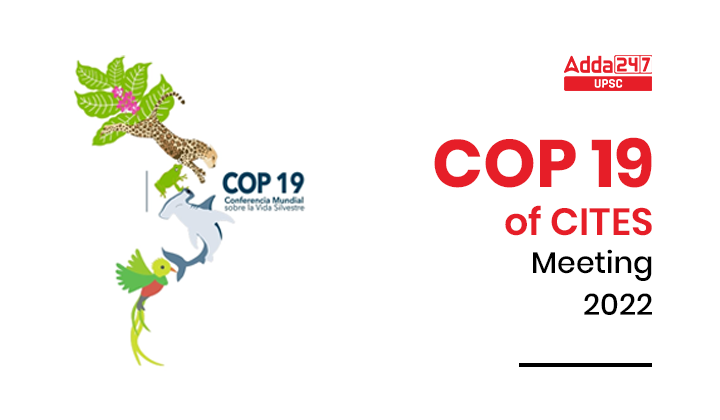Table of Contents
COP 19 CITES Meet UPSC Relevance
COP 19 of CITES: Convention on International Trade in Endangered Species of wild fauna and flora (CITES) is an international organization aimed at protecting various endangered Species by prohibiting trade of these species. CITES is important for UPSC Prelims Exam (International Convention regarding Environment and Wildlife Protection) and UPSC Mains Exam (International Relations).
COP 19 CITES 2022 in News
- Recently, at COP 19 of CITES Convention, India’s Shisham (Dalbergia sissoo) is included in Appendix II of the convention, thereby requiring to follow CITES regulations for the trade of the species.
- However, a relief provided by easing the CITES rules for export of Dalbergia sissoo based products. This is expected to boost Indian handicraft exports.
COP 19 Panama 2022
- The 19th meeting of the Conference of Parties to Convention on International Trade in Endangered Species of wild fauna and flora (CITES) is being held in the scenic city of Panama from 14th to 25th of November 2022.
How inclusion of Shisham (Dalbergia sissoo) Appendix II CITES affected India?
- As of now every consignment of weight above 10 kg requires CITES permit.
- Due to this restriction exports of furniture and handicrafts made of Dalbergia sissoo from India has been continuously falling from an estimated 1000 crore Indian Rupees (~129 million USD) per annum before the listing, to 500-600 crore Indian Rupees (~64 to 77 million USD) per annum after the listing.
- The decrease in exports of Dalbergia sissoo products has affected the livelihoods of around 50,000 artisans who work with the species.
Relief Provided to Indian Handicraft Exporter at COP 19 CITES
- On India’s initiative a proposal to clarify the quantity of Shisham (Dalbergia sissoo) items such as furniture and artefacts was considered in the COP 19 Panama meeting 2022.
- After sustained deliberations by Indian representatives, it was agreed upon that any number of Dalbergia sissoo timber-based items can be exported as a single consignment in a shipment without CITES permits if the weight of each individual item of this consignment is less than 10 kg.
- Further, it was agreed that for net weight of each item only timber will be considered and any other item used in the product like metal etc. will be ignored.
- This is a great relief for the Indian artisans and furniture industry.
How North Indian Rosewood or Shisham included in CITES?
- It may be recalled that in its 17th meeting of Conference of Parties (CoP) at Johannesburg, South Africa in 2016, included all species of Genus Dalbergia in Appendix II of the convention, thereby requiring to follow CITES regulations for the trade of the species.
- In India, the species Dalbergia sissoo (North Indian Rosewood or Shisham) is found in abundance and is not treated as an endangered species.
- During the discussion it was duly acknowledged by the parties that Dalbergia sissoo was not at all a threatened species.
- However, concerns were expressed regarding the challenges in distinguishing different species of Dalbergia in their finished forms.
- The countries expressed that there was an urgent need for developing advanced technological tools for distinguishing the finished wood of Dalbergia, especially at the Customs point.
- Considering this aspect and in the absence of a clear technology for distinguishing the finished wood, the CoP did not agree to de-list the Species from CITES Appendix:II.
- However, the relief given in terms of weight of each item will solve the problem of Indian artisan communities to a great extent and will give a tremendous boost to exports of articles produced by them.
What is CITES?
- CITES meaning: CITES is a global intergovernmental agreement to regulate or ban international trade in species under threat.
- CITES is an international treaty to prevent species from becoming endangered or extinct because of international trade.
- Under this treaty, countries work together to regulate the international trade of animal and plant species and ensure that this trade is not detrimental to the survival of wild populations.
- According to CITES, any trade in protected plant and animal species should be sustainable, based on sound biological understanding and principles.
- Although CITES is legally binding on the parties, it does not take the place of national laws. Rather it provides a framework to be respected by each Party, which has to adopt its own domestic legislation to ensure that CITES is implemented at the national level.
Mandate of COP of CITES
The CITES CoP convenes every two to three years to review the implementation of the CITES Convention, including:
- review progress in the conservation of species included in the Appendices;
- consider proposals to amend the lists of species in Appendices I and II;
- consider discussion documents and reports from the Parties, the permanent committees, the Secretariat and working groups;
- recommend measures to improve the effectiveness of the Convention; and
- make provisions necessary to allow the Secretariat to function effectively.
COP 19 Panama Summit of CITES FAQs
- Where is COP 19 CITES convention is being held?
Ans. CITES COP19 Convention is being held at Panama.
2. What is CITES?
Ans. CITES is a global intergovernmental agreement to regulate or ban international trade in species under threat.
3. How often CITES Conference of Parties (CoPs) are convened?
Ans. The CITES CoP convenes every two to three years to review the implementation of the CITES Convention.
Convention on International Trade in Endangered Species of Wild Flora and Fauna (CITES)
Convention on International Trade in Endangered Species of Wild Flora and Fauna (CITES)




 TSPSC Group 1 Question Paper 2024, Downl...
TSPSC Group 1 Question Paper 2024, Downl...
 TSPSC Group 1 Answer key 2024 Out, Downl...
TSPSC Group 1 Answer key 2024 Out, Downl...
 UPSC Prelims 2024 Question Paper, Downlo...
UPSC Prelims 2024 Question Paper, Downlo...





